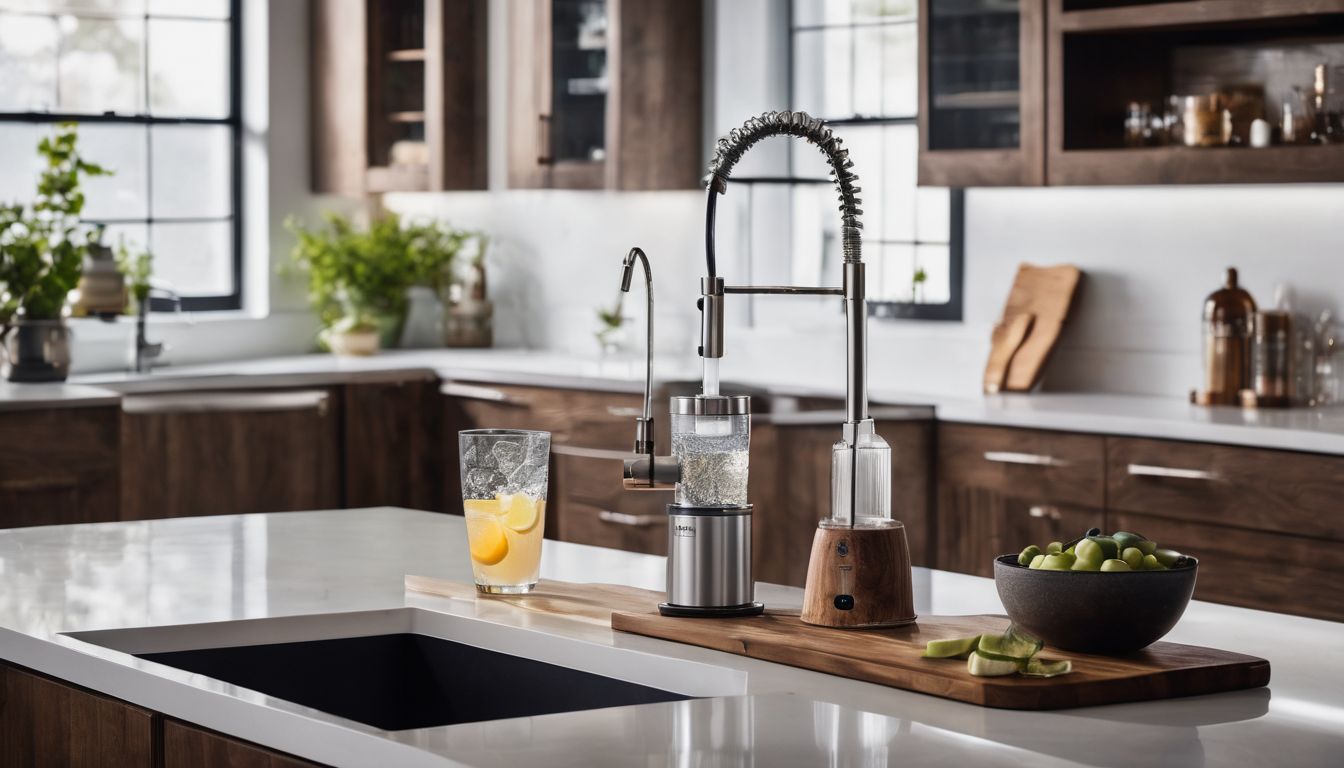Choosing the right roof is tough when you’re trying to be kinder to our planet. The good news: eco-friendly roofing can cut down your energy bills and help Earth too. Our guide shows off top green roofs that keep your home cosy, slash costs, and are better for nature.
Dive in for a greener tomorrow!
Key Takeaways
- Green roofs create natural habitats and improve insulation, while solar panels convert sunlight to energy for your house, cutting down on fossil fuel use.
- Metal roofs last a long time with little upkeep and are recyclable, making them kinder to the environment and your wallet over time.
- Cool roofs reflect more sunlight than standard ones, which means less heat in your home and lower air conditioning costs.
- Using reclaimed materials like clay tiles or synthetic shakes made from recycled plastic aids in waste reduction and preserves our planet’s resources.
- By choosing eco – friendly roofing options such as Brava Synthetic Roofing Tiles, you make a sustainable choice that benefits the ecosystem while enjoying economic advantages.
Why Choose Eco-Friendly Roofing for Your Home?
Choosing eco-friendly roofing for your home offers environmental benefits, cost savings in the long run, and reduces your carbon footprint. It’s a decision that positively impacts both the environment and your finances.
Environmental benefits
Eco-friendly roofing options not only minimise harm to the environment but actively contribute to its wellbeing. These sustainable materials often come from recycled sources, cutting down on waste and pollution.
As a result, they help maintain Earth’s delicate ecosystems by reducing the demand for new raw materials and energy-intensive production processes.
Green roofing alternatives like living roofs support biodiversity by providing habitats for plants and wildlife. Solar roofs harness clean energy directly from the sun, slashing greenhouse gas emissions that traditional power sources emit.
By opting for an eco-conscious roof design, you’re making a powerful statement: prioritising a future where homes coexist harmoniously with nature.
Cost savings in the long run
Transitioning from environmental benefits to cost savings, choosing eco-friendly roofing options ultimately leads to significant financial advantages. Sustainable roofing materials and designs contribute to long-term cost savings through reduced energy consumption, lower maintenance expenses, and extended roof lifespan.
With the use of energy-efficient roofing materials such as solar roofs or cool roofs, homeowners can enjoy decreased utility bills over time due to improved insulation and temperature regulation.
Furthermore, opting for environmentally friendly roof options like metal roofs or clay tiles can result in minimised replacement and repair costs while providing durable protection against adverse weather conditions.
Reduces carbon footprint
By choosing eco-friendly roofing materials, you can actively reduce your home’s carbon footprint. These sustainable options minimise the use of non-renewable resources and decrease the energy required for heating and cooling, contributing to a healthier environment.
Opting for green roofing alternatives, such as solar roofs or cool roofs, enables homeowners to make a positive impact on the planet by reducing greenhouse gas emissions and promoting energy efficiency.
When considering environmentally friendly roofing options, it’s vital to choose materials that not only benefit your home but also support conservation efforts and contribute to an overall cleaner ecosystem.
Types of Eco-Friendly Roofing Materials
There are various eco-friendly roofing materials to consider for your home, including cool roofs, solar roofs, metal roofs, living roofs, clay tiles, and synthetic shakes. Each option offers different environmental benefits and energy-saving features to suit your needs.
Cool roofs (white)
Cool roofs, also known as white roofs, are an excellent choice for eco-friendly roofing. These roofs are designed to reflect sunlight and absorb less heat, keeping your home cooler and reducing the need for air conditioning.
By choosing cool roof materials like white membrane or tiles, you can lower energy costs and decrease your carbon footprint. Additionally, these reflective surfaces contribute to a cooler environment in urban areas by reducing the urban heat island effect.
When considering eco-friendly roofing options, cool roofs are a top choice for those looking to make a positive impact on the environment while enjoying long-term cost savings.
Solar roofs
Solar roofs are a great option for those seeking energy-efficient and eco-friendly roofing solutions. These roofs consist of solar panels that harness the sun’s energy, converting it into electricity to power your home.
With renewable roof materials and low-impact construction, solar roofs contribute to a healthy ecosystem while reducing carbon footprint. They are an excellent choice for environmentally conscious individuals looking to embrace sustainable living through green building materials.
Utilising solar energy helps you save on electricity costs in the long run while supporting conservation efforts. By integrating renewable roofing options like solar roofs, you can play a part in promoting environmental sustainability and reducing reliance on non-renewable resources.
Metal roofs
Transitioning from solar roofs to metal roofs, these durable and low-maintenance roofing materials are an excellent choice for environmentally conscious homeowners. Metal roofs are highly sustainable due to their long lifespan and recyclability, making them a top pick for those focused on reducing their environmental impact.
With energy-efficient properties that help lower cooling costs and a wide range of designs to suit different architectural styles, metal roofs offer both eco-consciousness and aesthetic appeal.
Additionally, the use of recycled metal in roofing materials reduces the demand for raw resources while providing a durable and long-lasting solution for sustainable home construction.
Living roofs
Living roofs, also known as green roofs, are an excellent option for environmentally conscious homeowners. These roofing systems feature a layer of living vegetation, which not only provides insulation but also helps absorb rainwater and reduce urban heat.
Constructed using hardy plants, living roofs offer excellent energy efficiency and contribute to a healthy ecosystem by providing habitats for birds and insects. By choosing living roofs, you can actively support conservation efforts while reducing your carbon footprint.
Implementing eco-friendly initiatives like installing living roofs can have a positive impact on the environment while creating a healthier living space for you and your family. Whether it’s about incorporating recycled materials or opting for sustainable designs – every choice counts in supporting environmental conservation.
Clay tiles
Clay tiles offer an eco-friendly roofing option for environmentally conscious individuals. These tiles are made from natural clay, which is abundant and sustainable, making them an ideal choice for those supporting environmental conservation.
The production process of clay tiles also has a lower environmental impact compared to other roofing materials, aligning with the values of ecosensitive construction and sustainable roof design.
Additionally, when considering low-impact roofing choices, clay tile roofs stand out for their durability and ability to withstand harsh weather conditions. Their longevity contributes to reduced waste as they don’t need frequent replacements like some other roofing materials.
Synthetic shakes
Having explored the eco-friendly option of clay tiles, now let’s delve into synthetic shakes. These roofing materials offer an environmentally sustainable alternative to traditional wooden shakes.
Made from a combination of recycled plastic and rubber, synthetic shakes provide durability and resistance to weathering, making them an appealing choice for those seeking long-term, low-impact roofing solutions.
Synthetic shakes boast a longer lifespan than natural wood options and are often fire-resistant, offering peace of mind for homeowners concerned about safety and environmental impact.
Factors to Consider When Choosing Eco-Friendly Roofing
When choosing eco-friendly roofing, consider factors such as energy efficiency, durability, embodied energy, and recycling and reusability to ensure a sustainable and environmentally conscious choice for your home.
Read on to discover the benefits of different eco-friendly roofing materials.
Energy efficiency
Eco-friendly roofing materials contribute to energy efficiency, reducing your home’s carbon footprint and energy bills. Cool roofs with reflective surfaces help lower indoor temperatures, decreasing the need for air conditioning.
Solar roofs harness sunlight to generate electricity, providing a sustainable energy source. Metal roofs have high solar reflectance and thermal emittance, enhancing energy efficiency by keeping homes cooler in hot climates and warmer in cold weather.
These options promote environmentally sustainable living while reducing reliance on non-renewable resources.
Living roofs improve insulation, lowering heating and cooling costs by regulating indoor temperatures naturally. Synthetic shakes made from recycled materials offer durability and insulation properties, supporting energy-efficient construction practices.
Durability
Considering the eco-friendly material’s lifespan is vital. It withstands harsh weather, ensuring a longer roof life cycle and less frequent replacements. This also reduces waste and conserves resources, aligning with your environmental goals.
Metal roofs, for instance, can last up to 50 years or more, while clay tiles are known to endure for centuries. These durable options not only provide long-term protection but also require fewer raw materials over time.
The resilience of eco-friendly roofing materials ensures you won’t need frequent repairs or replacements. By selecting long-lasting options, you’re making a sustainable choice that minimises environmental impact across your roof’s lifetime.
Embodied energy
Considering the environmental impact of roofing materials is crucial when aiming for an eco-friendly home. Embodied energy, which refers to the total energy required to produce a product, including raw material extraction, processing, manufacturing, transportation, and installation, plays a significant role in determining the sustainability of roofing options.
When choosing eco-friendly roofing materials with low embodied energy levels such as cool roofs and metal roofs, you actively contribute to reducing your home’s carbon footprint while promoting sustainable practices.
By prioritising low-impact roofing choices that minimise embodied energy consumption, you enhance the overall environmental friendliness of your home.
Investing in roofing materials with lower embodied energy not only positively impacts the environment but also aligns with cost-efficient long-term solutions for homeowners seeking environmentally sustainable alternatives.
Energy-efficient roof designs coupled with recycled roof materials provide practical advantages in creating greener living spaces while minimising the ecological burden associated with conventional construction practices.
Recycling and reusability
When considering eco-friendly roofing materials, it’s important to prioritise recycling and reusability. Opting for materials that can be recycled or repurposed at the end of their lifespan helps reduce environmental impact.
Choosing roofing options such as metal roofs or synthetic shakes not only contributes to waste reduction but also supports a sustainable approach to home construction. By selecting roof materials with recycling and reusability in mind, you actively participate in conserving natural resources and promoting a healthier environment for future generations through your housing choices.
Contribution to a healthy ecosystem
Choosing eco-friendly roofing materials contributes to a healthy ecosystem by reducing environmental impact and promoting sustainability. By using materials that are recyclable, reusable, or made of renewable resources, you can help minimise waste and protect natural resources.
Additionally, eco-friendly roofing options such as cool roofs and green roofs can also reduce urban heat islands, improve air quality, and provide habitats for wildlife. Making environmentally sustainable choices for your roof not only benefits your home but also positively impacts the broader environment.
When selecting eco-friendly roofing materials like solar roofs or metal roofs, you actively contribute to a healthier planet by harnessing renewable energy sources and reducing reliance on non-renewable resources.
The Benefits of Different Eco-Friendly Roofing Materials
From cool roofs for minimalists to solar roofs for tech enthusiasts, there’s an eco-friendly roofing material for every homeowner. Read on to discover the best option for your home.
Cool roofs: best for minimalists
Cool roofs, with their reflective surfaces, are ideal for minimalists who appreciate simplicity and efficiency. These roofs come in a variety of light colors that reflect sunlight rather than absorbing it, keeping homes cooler during hot weather.
The use of eco-friendly materials ensures a lower environmental impact, making them an attractive option for individuals seeking energy-efficient roofing solutions. Additionally, cool roofs can help reduce urban heat islands in densely populated areas, contributing to overall environmental sustainability.
Minimalists looking for roofing options aligned with their lifestyle will find that cool roofs not only offer a sleek and modern aesthetic but also support their commitment to reducing energy consumption and promoting environmental consciousness.
Green roofs: best for nature lovers
Green roofs provide a lush habitat for plants, offering a haven for wildlife and contributing to urban biodiversity. These living roofs also help filter pollutants from rainwater, contributing to cleaner air and water in your local ecosystem.
By choosing green roofing options, nature lovers can actively support the conservation of plant and animal life while creating a beautiful natural space.
For those who value sustainability and want to foster an environment that supports local flora and fauna, green roofs are the ideal choice. With their ability to create a thriving ecosystem on your rooftop, these eco-friendly roof designs allow you to truly connect with nature in an urban setting.
Metal roofs: best for long-term thinkers
Metal roofs are a top choice for long-term thinkers seeking eco-conscious roofing solutions. These roofs have an impressive lifespan, often lasting 50 years or more, reducing the need for frequent replacements and significantly minimising environmental impact.
Additionally, metal roofs can be recycled at the end of their life, making them a sustainable option that contributes to a healthier ecosystem. Along with energy efficiency and durability, metal roofs offer an enduring and environmentally friendly solution for those looking towards the future.
When considering eco-friendly roofing options, it’s important to recognise the benefits of each material in order to make an informed decision that aligns with both your values and practical needs.
Reclaimed clay roofs: best for eco-friendly elegance
Reclaimed clay roofs offer eco-friendly elegance, making them ideal for environmentally conscious individuals. These roofs contribute to sustainability by repurposing materials and reducing waste.
They provide a timeless aesthetic while also promoting environmental responsibility through their unique charm and durability. With their earthy tones and natural textures, reclaimed clay roofs enhance the visual appeal of homes, aligning with the values of conservation and environmental support.
The use of reclaimed clay in roofing solutions underscores a commitment to preserving resources and minimising the ecological impact of construction projects. By incorporating these eco-friendly options, homeowners can embrace stylish elegance without compromising their dedication to sustainable living practices.
Slate tile roofs: best for stone and brick homes
Slate tile roofs suit stone and brick homes due to their timeless appeal and durability. The natural stone tiles offer a classic, elegant look that complements the aesthetic of these architectural styles.
Additionally, slate is a sustainable roofing option as it has a long lifespan, reduces energy consumption, and requires minimal maintenance. Its eco-friendly nature aligns with the ethos of environmentally conscious homeowners looking for low-impact roofing solutions that blend seamlessly with their traditional home design.
When considering eco-friendly roofing options for stone or brick homes, slate tile roofs stand out as an ideal choice in terms of sustainability and visual appeal.
Solar roofs: best for tech enthusiasts
Solar roofs are the perfect choice for tech enthusiasts who are passionate about sustainable energy solutions. By harnessing the power of the sun, solar roofs not only provide a high-tech and futuristic appeal but also contribute to reducing carbon emissions and reliance on non-renewable energy sources.
With advanced technology embedded in these roofs, they seamlessly integrate with smart home systems, allowing tech-savvy homeowners to monitor their energy production and consumption efficiently.
These innovative roofing solutions offer a dual benefit – they enhance your home’s eco-friendly profile while appealing to those who appreciate cutting-edge technological advancements.
Our Top Recommendation for the Best Eco-Friendly Roofing Option: Brava Synthetic Roofing Tiles
Brava Synthetic Roofing Tiles offer an eco-friendly solution for environmentally conscious homeowners. These energy-efficient roofing materials provide a durable and sustainable option that reduces the carbon footprint of your home.
Made from recycled and recyclable materials, Brava synthetic tiles are an earth-friendly choice that contributes to a healthy ecosystem while providing long-term cost savings. With their low-impact production and environmentally sustainable design, Brava Synthetic Roofing Tiles are the ideal choice for those seeking reliable, eco-conscious roof construction.
When considering eco-friendly roofing options, it’s essential to prioritise sustainability without compromising on quality. Brava Synthetic Roofing Tiles embody this ethos by offering a durable, innovative solution that meets the demands of both homeowners and environmental enthusiasts alike.
Conclusion
In conclusion, eco-friendly roofing options offer numerous benefits for your home and the environment. With a variety of materials to choose from, there is something suitable for every homeowner’s needs and preferences.
Making the switch to an eco-friendly roof not only reduces your carbon footprint but also contributes to long-term cost savings and supports conservation efforts. Consider the different types of eco-friendly roofing materials available and make a positive impact on both your home and the planet.
FAQs
1. What are some eco-friendly roofing options for my home?
There are several eco-friendly roof designs, including energy-efficient roofing materials and eco-sensitive shingle options.
2. Why should I consider eco-conscious roof construction?
Eco-conscious roof construction reduces environmental impact and often results in energy savings due to better insulation.
3. Can environmentally sustainable roofing materials be stylish?
Yes, earth-friendly roof materials come in various styles and colours, offering both aesthetic appeal and low-impact on the environment.
4. Are there energy-efficient options for flat roofs?
Absolutely! Energy-efficient roofing can be designed for both sloped and flat roofs, providing earth-friendly roof solutions no matter your home’s design.
5. How do eco-friendly shingle options compare to traditional ones?
Eco-friendly shingle options not only minimise harm to the planet but also tend to last longer than standard shingles, making them a smart choice for environmentally conscious homeowners.





